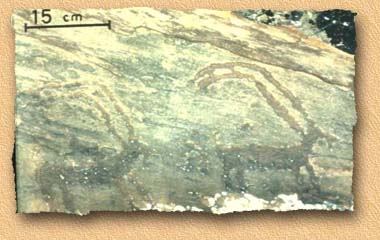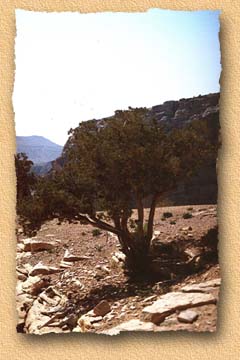

 |
| The Blue Sinai lizard is common within the Petra Region. Photo by Jane Taylor, all rights reserved |
In recognition of the urgent need to protect and conserve the flora and fauna resources of Petra, the Petra National Trust initiated a study/survey in 1996. The Petra National Trust, in conjunction with the Global Environmental Facility (GEF), began focusing its efforts on studying an important aspect of ecological conservation, that of biological diversity in the Petra area.
Although most tourists come to Petra for its unique and well-preserved carved monuments, the ecology also forms an integral part of the site. The region has had a high level of human activity for thousands of years, which has created stress not only on the archaeological remains, but on all life systems. The ultimate challenge the Petra region faces is to maintain a balance between development and preservation of the ecosystem.
The Climate
Petra has two seasons-a hot and dry summer and a mild and wet winter. It receives approximately 20cm of rain each year during its rainy season. In the summer the average temperature is 26.8°C, while during the winter it is 6°C.
Over the centuries, there has been substantial desertification within the Petra area. Contributing factors are overgrazing of goats and sheep, which decreases the vegetation cover, and flash flooding, which washes away the unanchored topsoil. Long periods of hot and dry weather followed by a short and intense rainy season also help to create a desert climate.
 |
| An ancient Nabataean inscription of the native Ibex, showing their existence in the area dating back thousands of years. Photo by Dr. Dici, all rights reserved |
Petra's Ecological Importance
The Petra area is of strategic ecological importance because it is located at a meeting point of three zoogeographic realms: the Palearctic, Afrotropical, and Saharo-Arabian. The unique topography of the Petra area, overlooking the Rift Valley, has added to the intermingling of the vertebrate fauna from different regions, and has resulted in the heterogeneity of the vertebrate in this area. These combined factors allow for studying the interaction of the vertebrates, which have descended from different zoogeographical origins. Petra is also the southernmost limit for many reptiles and mammals, and one amphibian migrating from the Palearctic region (Europe).
The variety and richness of plant life in the Petra area is proverbial. The Petra region is located at the edge of the Mediterranean ecosystem and is characterized by the presence of many endemic plant species adapted to a narrow range of environmental requirements. One of man's earliest settlements is in Beidha where he domesticated and cultivated animal and plant species, mainly wheat. The Petra area is also the southernmost geographical limit for the growth of the Allepo Pine (Pinus Halepemsis); it used to host a large number of this species before the Ottoman Empire.
Threats to Biodiversity
Since the signing of the Middle East Peace Treaty in 1994, there has been an increase in tourism to Petra. While the infrastructure to handle such an increase is being met in the areas surrounding Petra, visitor circulation and commercial activities that pose a direct threat to the ecological balance have yet to be addressed. Many more changes in the management of the area still need to be implemented. Other major threats to biodiversity in the Petra area are habitant alteration and overharvesting of edible plants. Destroying the habitats of species reduces them and results in the loss of genetic diversity.
The Nabataeans designed an intricate network of water systems to protect their environment, and to fulfill their needs for water for their daily requirements and for agriculture and industry. This system was also designed to protect the area from the negative impact that flash floods, common to this area, have on vegetation and soil. Over the centuries, Petra suffered a gradual decline, and so did its hydraulic systems and hence vegetation cover.
The Aims and Results of the Flora and Fauna Study
By conducting a study/survey, the PNT aimed to find and record the current status of all the flora and fauna in Petra. Each species was recorded as being abundant, common, endemic, rare or endangered. The Importance Value (IV) of the flora, which is a community parameter, was estimated using standard quantitative techniques based on density, coverage, and frequency. Photographs were taken of each species the researchers spotted during the study, to be kept on record for future use. The data retrieved from the fauna study reveals that the region contains 155 species of insects, 1 amphibian species (bufo viridis), 42 species of reptiles (of which one is a relict species), 111 species of birds, and 29 species of mammals.
Petra also has a large variety of avifauna. Its bird population contains 36 percent passage migrants, 23 percent residents, 19 percent migrants and 5 percent migrants and breeders, 4 percent vagrants, 8 percent residents and migrants, 3 percent migrants and possible breeders, and 2 percent vagrants and possible breeders. A number of the birds of Petra are transients involved in the spectacular annual migrations from Eurasia to Africa, making Petra an essential site for studying the passage of raptors and other migratory birds. Raptors migrate south from Northern Europe through Turkey, Syria, Lebanon, and the Jordan Rift Valley where they seek shelter and build their nests in the high cliffs. They then use the hot air currents for gliding.
Interestingly, of the 29 species of mammals, 11 are considered rare and endangered, according to IUCN categories. This is mainly due to hunting and habitat destruction. Livestock grazing and depletion of water resources are also considered as major causes for the loss of biodiversity. The ibex, once a common species in the region, is endangered. Its population is now being regenerated within several wildlife reserves in Jordan and is expected to be reintroduced to Petra in the future.
 |
| The Phoenician Juniper tree is endangered due to trampling and over-grazing. PNT Photo |
The data retrieved from the flora study identifies 560 plant species, of which many are endemic, rare, or endangered. Due mainly to overgrazing and trampling, there are two tree species that are being threatened with extinction: Phoenician Juniper and cypress. Approximately 28 cypress trees have been found in the Petra area to date. The stands of both these species are very old, containing few young plants. This has been attributed to the grazing of seedlings, trampling of the ground, changing soil conditions and loss of seed material to erosion. Old trees, moreover, produce relatively few live seeds, and a high proportion of those seeds are affected by attacks of insects and fungus. Old Phoenician Junipers produce only 5 percent of live seeds compared to the 80 percent from the younger junipers.
There is also a wide variety of medicinal plants that grow in Petra. Bulbs of the Sea Squill are used for heart disease and cough mixtures. Bulbs of the Red Squill, which grow in this area, are used to produce rat poison. The plants, if cultivated, can provide income for the local community.
Many plants, mainly the Ficus carica, due to their resilient root systems, endanger Petra's stone-carved monuments; they grow into the crevices and fissures of the rock and cause irreparable damage if not removed. The Phoenician Juniper can only grow in rock crevices.
Future Projects
Since the completion of the Flora and Fauna study, several projects to revive and protect the indigenous vegetation to the area have been proposed. Petra National Trust has initiated proposals for the creation of trails, species regeneration, and animal management, all with the goal of promoting Petra's unique flora and fauna.
